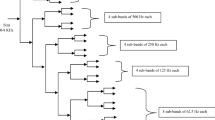Abstract
Nonlinear feature extraction of speech signals has been the main concern of many researches in recent years. In this paper, feature extraction of phonemes using NPC (neural predictive coding) model is generalized to a combination of time and DCT domains. Two main ideas were proposed and evaluated in this paper. First, a frame-wise DCT-based NPC feature extractor is proposed to overcome the computational complexity deficiency of the system. The basis of this approach is the application of a DCT pre-feature extractor to remove unwanted additional data. In this approach, the extracted features are the output of the hidden layer. It is shown that the use of a pre-processing stage can improve both computational complexity efficiency and accuracy issues. At the second approach, we proposed a complementary role for DCT domain features in classic NPC modeling. This approach uses the signal residual of the predicted signal in the DCT domain. The experiments were conducted on voiced plosive phonemes of TIMIT database. Simulations showed that the performance of the combined method is good at the plosive phonemes. The achieved accuracy that was resulted from the proposed method was 70.3% recognition rate on /b/d/g/ phonemes, which is higher than the results of traditional NPC approaches.












Similar content being viewed by others
References
Markel JD (1976) Linear prediction of speech. Springer, Berlin
Anusuya MA, Katti SK (2009) Speech recognition by machine: a review. Int J Comput Sci Inf Secur 6:181–205
Shi G, Shanechi M, Aarabi P (2006) On the importance of phase in human speech recognition. IEEE Trans Audio Speech Lang Processing 14:1867–1874
Garimella S, Nemala SK, Elhilali M, Tran TD, Hermansky H (2010) Sparse coding for speech recognition. The IEEE International Conference on Acoustics, Speech, and Signal processing, ICASSP’10, March Dallas, Texas, USA
Zhao SY, Morgan N (2008) Multi-stream spectro-temporal features for robust speech recognition. Proc. Interspeech 898–901
Mesgarani N, Sivaram GSVS, Nemala SK, Elhilali M, Hermansky H (2009) Discriminant spectrotemporal features for phoneme recognition. 10th annual conference of the international speech communication association (INTERSPEECH), Brighton
Zamalloa M, Bordel G, Rodriguez LJ, Penagarikano M. (2008) Feature selection based on genetic algorithms for speaker recognition, pp 1153–1154
Beritelli F, Casaie S, Russo A, Serrano S (2005) A genetic algorithm feature selection approach to robust classification between “positive” and “negative” emotional states in speakers. Signals Syst Comput 550–553
Holland JH (1986) Escaping brittleness: the possibilities of general-purpose learning algorithms applied to parallel rule-based systems. In: Michal-ski Rs, carbonell JG, Mitchell TM (eds) Machine learning—an artificial intelligence approach, vol 2, pp 593–624
Chetouani M, Gas B, Zarader J-L, Chavy C (2002) Neural predictive coding for speech discriminant feature extraction. ESANN, pp 275–280
Gas B, Zarader J-L, Chavy C, Chetouani M (2004) Discriminant neural predictive coding applied to phoneme recognition. Neurocomputing 141–166
Tishby N (1990) A dynamical system approach to speech processing. In: Proceedings of international conference on signal and speech processing, vol 1. Albuquerque, NM, USA, pp 365–368
Waibel A, Hanazawa T, Hinton G, Shikano K, Lang K (1989) Phoneme recognition using time-delay neural networks. IEEE Trans ASSP 37:328–339
Atal Bs, Schroeder MR (1968) Predictive coding of speech signals. Report of the 6th international congress on acoustics. Tokyo, Japan
Lapedes A, Farber R (1987) Nonlinear signal processing using neural networks: prediction and system modelling. Internal Report, Los Alamos National Laboratory
Gas B, Zarader JL, Chavy C, Chetouani M (2001) Discriminant features extraction by predictive neural networks. In: WSES international conference in signal speech and image processing (SSIP01). Advances in signal processing and communications. Malta, pp 64–68
Chetouani M, Faundez-Zanuy M, Gas B, Zarader JL (2004) A new nonlinear feature extraction algorithm for speaker verification. In: International conference on spoken language processing (ICSLP 04). Jeju Island, Korea
Andrés Berzala J, Zufiria PJ (2007) Dynamic behavior of DCT and DDT formulations for the Sanger neural network. Neurocomputing 70:2768–2774
Yousefi Azar M, Razzazi F (2008) A DCT based nonlinear predictive coding for feature extraction in speech recognition systems. Istanbul-Turkey, CIMSA 2008. IEEE international conference on computational intelligence for measurement systems and applications, pp 19–22
Sunitha SL, Udayashankara V (2006) Fast recursive DCT-LMS speech enhancement For performance enhancement of digital hearing aid. Academic Open Internet J 18
Gas B, Zarader JL, Chavy C (2001) A new approach to speech coding: the neural predictive coding. J Adv Comput Intell 4:120–127
Zhu X, Wyse L (2004) Sound texture modelling and time-frequency LPC. In: Proceedings of the 7th international conference on digital audio effects DAFX’04, Naples
Athineos M, Ellis D (2003) Sound texture modeling with linear prediction in both time and frequency domains. In: Proceedings of IEEE international conference on acoustics, speech, and signal processing ICASSP’03, vol 5, pp 648–51
The DARPA TIMIT Acoustic-Phonetic Continuous Speech Corpus (TIMIT) (1990) Speech disc. 1-1.1/NTIS.PB91-505065
Huang X, Acero A, Hon H (2001) Spoken language processing. A guide to theory, algorithm, and system development. Prentice Hall, Englewood Cliffs
Jain A (1989) Fundamentals of digital image processing. Prentice Hall, Englewood Cliffs
Samir JS, Ahmad AM (2009) Neural networks based time-delay estimation using DCT coefficients. Am J Appl Sci 703–708
Author information
Authors and Affiliations
Corresponding author
Rights and permissions
About this article
Cite this article
Yousefi Azar, M., Razzazi, F. A neural predictive coding feature extraction scheme in DCT domain for phoneme recognition. Neural Comput & Applic 21, 565–574 (2012). https://doi.org/10.1007/s00521-010-0450-0
Received:
Accepted:
Published:
Issue Date:
DOI: https://doi.org/10.1007/s00521-010-0450-0




